Commuter Cycling in East Nashville
I want to talk about cycling for a moment. I live in East Nashville and I work downtown. The neighborhood’s proximity to downtown is ideal for a daily bicycle commute. My ride is approximately five miles, which can be accomplished in less than half an hour. In spite of the nice bike lanes on my side of town, the interstate creates a barrier that discourages commuters from cycling. Herein I attempt to explain why.

The above illustrates all of the possible routes into downtown Nashville from the east side. I did omit Crutcher Street, but it’s so close to Davidson Street that I’m more or less lumping the two together.
Let’s take each of these options one by one, starting from the northernmost access.
Spring Street
This street, theoretically, has a “bike lane.” Here’s a shot of it.
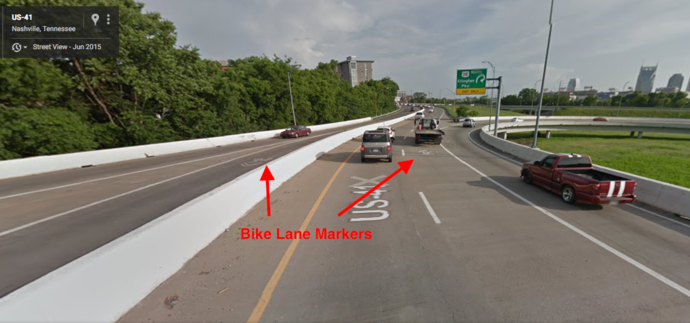
I presume these chalked lines indicate that this is a “shared” road. Either that or it’s the chalk outlines of where they found the bodies of cyclists fool-hardy enough to take this route. We have multiple lanes of traffic, some of which exit off of and enter onto Ellington Parkway. The only lane of choice for a cyclist is the center lane where they are caught in merging traffic. Furthermore, the road is in a curve so visibility is at a minimum. A vehicle overtaking a cyclist would not see them until the last possible moment.
If you travel along this road headed into downtown, you’ll find yourself here.
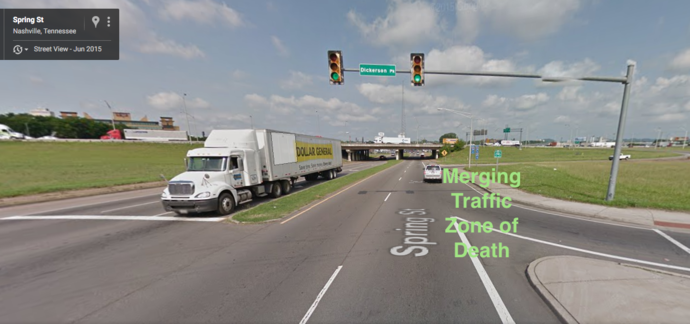
Here you will encounter cars coming off of Dickerson Pike, merging with Interstate 65 North and South. You can ride in the right lane, but cars are going to be annoyed at you for blocking their entrance and exit and yes they are going to blow their horn and yell at you to get on the sidewalk. Beyond being annoying, this is yet another horribly dangerous intersection that is not suitable for commuting cyclists.
Here’s a close-up of the route where you can see all of the merging lanes and general mayhem this route would have in store. It’s a veritable gauntlet.
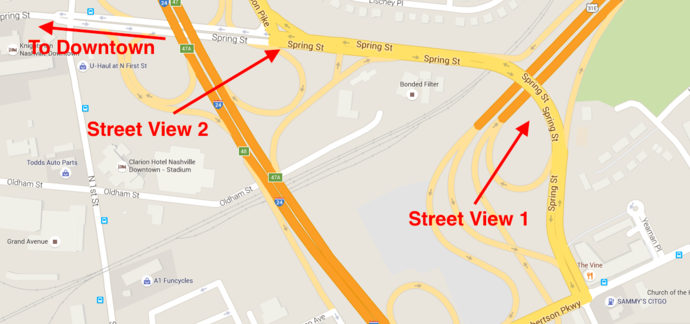
I have driven this route for years now and I have yet to see a single cyclist on Spring Street. This is, practically, not an option. To call it a bike route is an insult to the English language. It is meaningless.
Let’s move on to the next route.
Main Street
This route, also, has a “bike lane.”
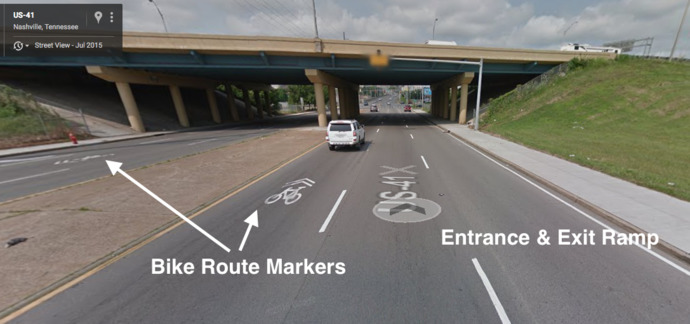
Unfortunately, it is also afflicted with the problem of Interstate 65 ramps on both sides. Again, the cyclist is forced into a center lane and into the wrath of the motorized vehicles. You also have to contend with the fact that Main Street funnels from two lanes to one lane when you cross 5th Avenue as well as the Ellington Parkway off-ramp. All of this is quite intimidating, and even if you obey the laws of the road, vehicles will be annoyed that you’re not over to the side (in the merge lane).
The other side of the interstate isn’t much better. This is looking towards downtown but you get a sense of what the street-scape is like in both directions.
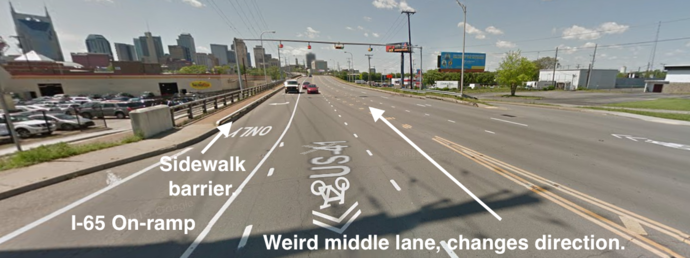
You’ve got five lanes of traffic. Typically during rush hour this is a very busy street. Cars are entering and exiting the interstate. The middle lane on Main Street south of the Interstate switches direction based on traffic. You have five lanes of traffic all the way from the Interstate to downtown. Everything about this road is set up to accommodate vehicles - there is very little concession made to either pedestrians or cyclists.
Here’s an aerial shot of the whole mess.
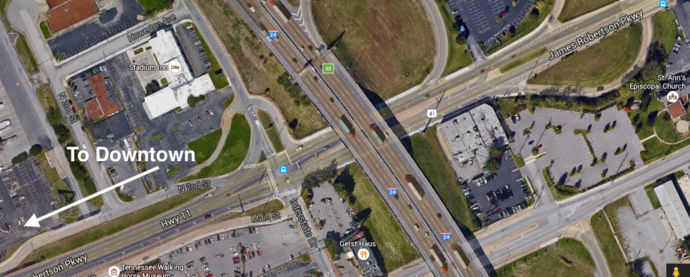
This option is certainly better than Spring Street, but it’s still terrifying. Let’s see what Woodland Street holds in store.
Woodland Street
This street has no designated bike route. However, at first glance it looks like a really great route. Here’s a shot looking towards downtown.
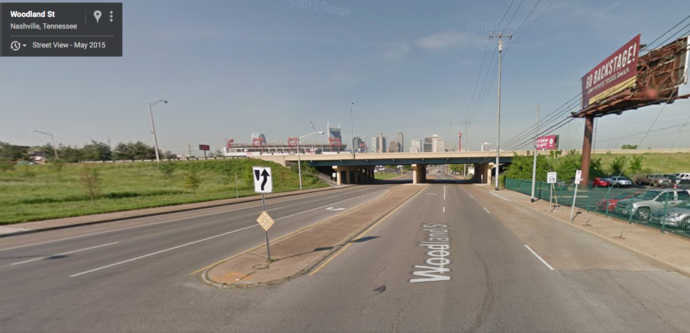
On the southbound side you have no exit or entrance ramps. Sure, there are two lanes but otherwise this is pretty smooth sailing. No one is going to be mad at you for riding in the right-hand lane. If you are coming south down Woodland Street and you cross 5th Street, there’s a short length where cars behind you must be careful about passing while there is only one lane. Alas, they are not always careful, but one lane quickly becomes three, giving you plenty of room to stay to the right.
This is actually my preferred route into downtown.
How about heading back home? Alas, we’re again faced with another entrance ramp.
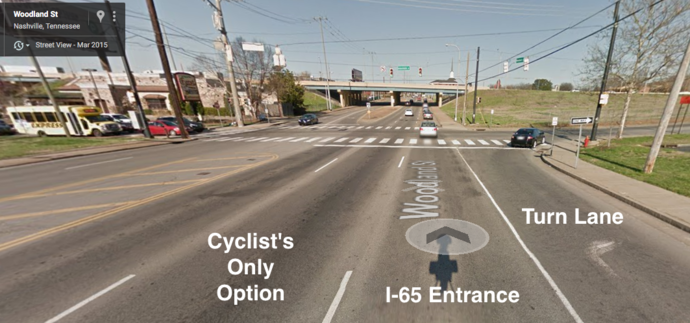
Not only is there an entrance lamp, but the far right hand lane is a turn lane. This forces the cyclist into the second left-most lane. Again, we’re faced with the wrate of the drivers encased in steel and glass who cannot understand why this crazy man on a bicycle is slowing them down. They toot their horns, roll down their windows, yell, swear, and generally act like imbeciles. I generally do not take this route as I do not like to deal with angry drivers. It is, I suspect, discouraging to anyone wishing to commute via bicycle.
You can, of course, choose to ride on the sidewalk but you will need to be very careful about cars entering the interstate and turning onto Interstate Drive. Furthermore, there have been several studies that have shown that riding on the sidewalk is nearly twice as dangerous as riding in the road. Therefore, I do not consider riding on the sidewalk here to be a viable option.
What are our other options, then? Let’s take a look at Shelby Avenue.
Shelby Avenue
This corridor into downtown, which includes the Korean Veterans Bridge, has undergone a lot of changes in the past few years. There has been a bicycle lane down Shelby for some time now, but it’s a little spotty in that it cuts in and out and occasionally leaves you stranded on a fairly busy street.
Still, there is a bicycle lane and that’s certainly an improvement.
(Note the Bcycle-ist running against traffic patterns. This is something I see a lot of in Nashville - maybe the state has not done a great job of educating folks about walking on the left, riding on the right? It’s terribly awkward to try to safely pass these folks and deal with traffic at the same time.)
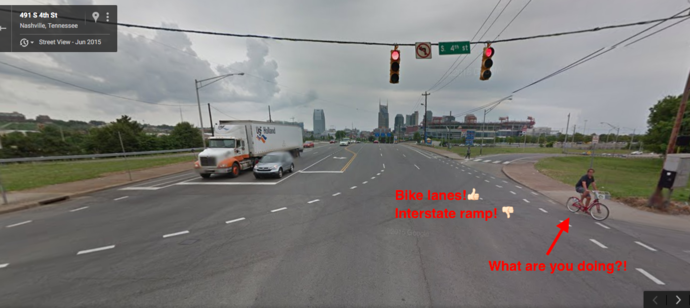
This route is a little more intimidating coming from the other direction. The bike lane is there, but you have to really watch for folks moving to the left lane (another Interstate on-ramp). They are technically supposed to yield to cyclists, but they are not always great about doing so.
Still, there is a bicycle lane, so one would expect that motorists would start to acclimate to seeing cyclists on the path.
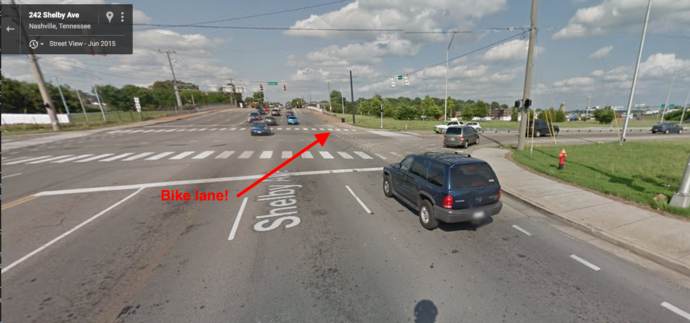
This route also experiences heavy traffic during rush hour (and heaven help you if you decide venture this route on a game day). There are six lanes of traffic to contend with, plus the on ramps and lane changes. It’s not something I have found to be within my comfort level as a casual cyclist commuter. However, it’s not all that bad. It does have proper lanes, at least.
If you’re coming from the north side of town, however (Dickerson Pike or anywhere west of Gallatin Pike or Main Street) it is difficult to get to. You will need to come down 5th Street (where there is no bicycle lane) or try to cross on one of the smaller streets (e.g., 9th).
Last, let’s look at one option that has no interstate entrance ramps at all, which makes it by far the least stressful option.
Davidson Street
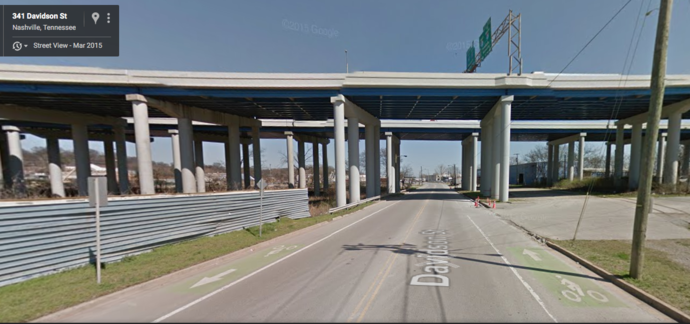
This street view is actually out of date. The bicycle lane you see above has been replaced with a buffered split lane that runs along the south side of Davidson Street. It’s quite nice (even if it does pose a problem for some motorists who do not look to their right when entering Davidson Street). There are also no ramps onto I-65. It’s not beautiful (it runs through a metals trash dump) but that can hardly be a valid complaint.
The only problem with this route is that if you need to travel in any direction north of Nashville (anywhere west of Woodland street) it is rather out-of-the-way. It adds two miles to my commute, but it’s such a lower level of stress that I’m happy to add the additional time to get home.
Conclusion
One of my favorite things about living in Nashville’s urban core is the ability to take alternative forms of transportation to work. One of the reasons many people choose to live in East Nashville is the proximity to the downtown area: encouraging new residents to embrace alternatives will make the city a better place to live by reducing traffic, pollution, and improve emotional and physical well-being. Planners would do well to continue making efforts to make it more attractive to casual cyclists. Here are some suggestions.
- Provide better routes from the north side of town, particularly the Dickerson Pike corridor.
- Make some concessions to pedestrians and cyclists on either Woodland or Main Street in the form of buffered bike lanes, better sidewalk markings (especially when crossing entrance and exit ramps) and minimizing lane shifts.
- Educate cyclists that they are subject to the same rules as motorists.
- Educate motoricsts that cyclists can take up a full lane and are to use the road in generally the same manner as a vehicle.
Other Resources
If you cycle to work, make sure to read BicycleSafe.com. You should be familiar with all of the common ways cyclists put themselves in danger and how to avoid them. I try to go back and read it at least once a year.
Your thoughts?
If you cycle in this part of Nashville, I would love to hear your opinion. What do you feel can be done to improve the appeal of commuting to downtown via bicycle to the casual cyclist?
